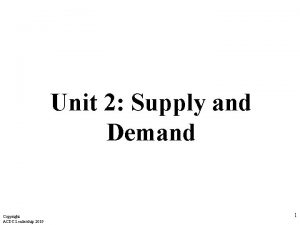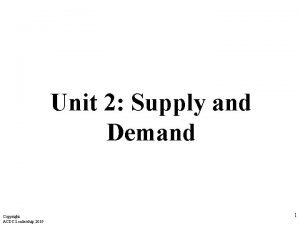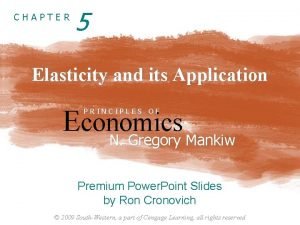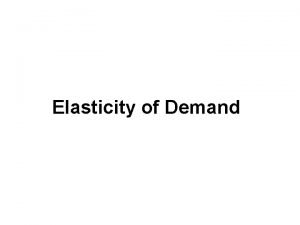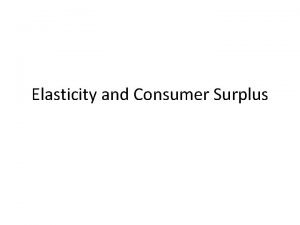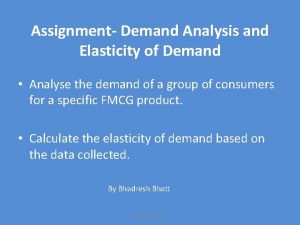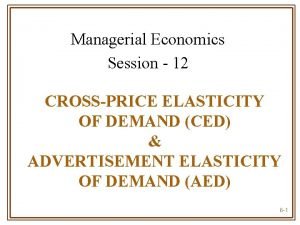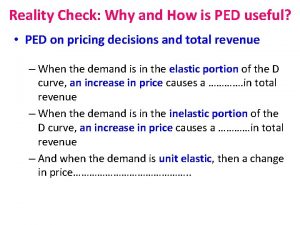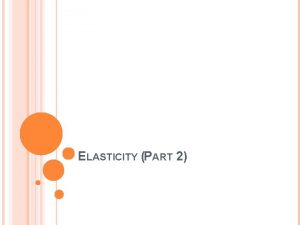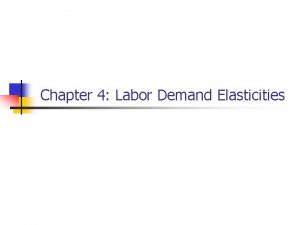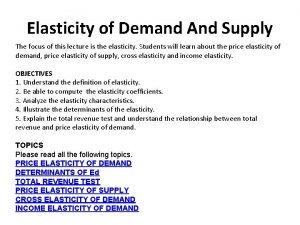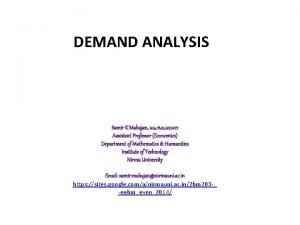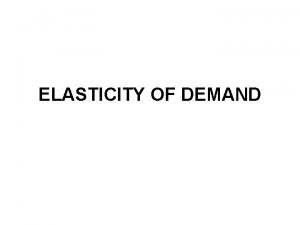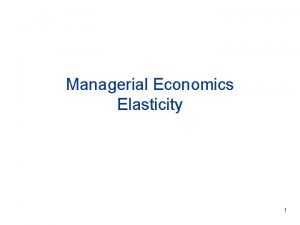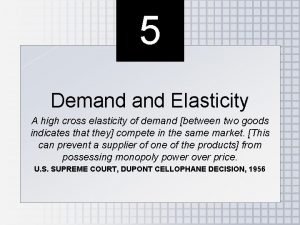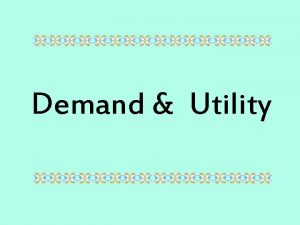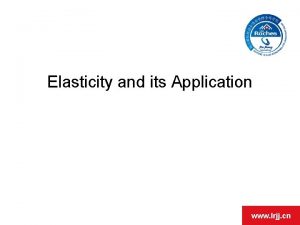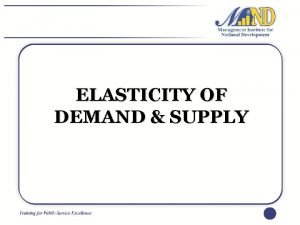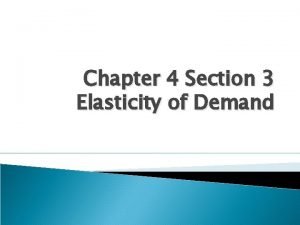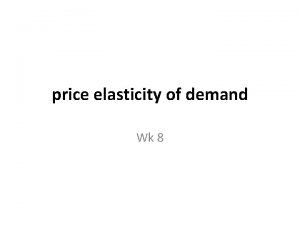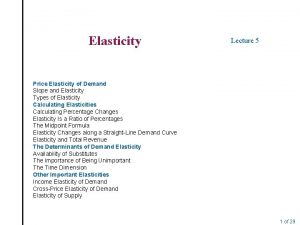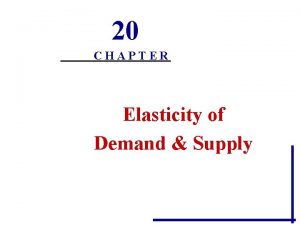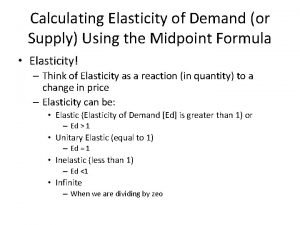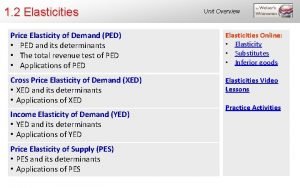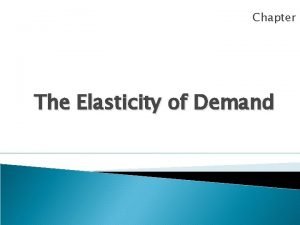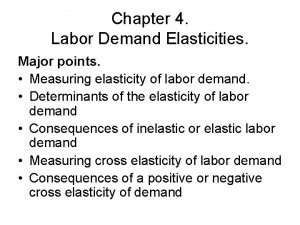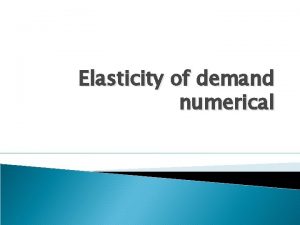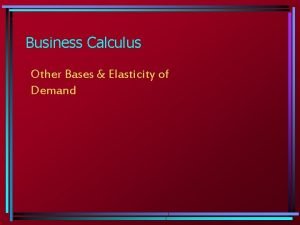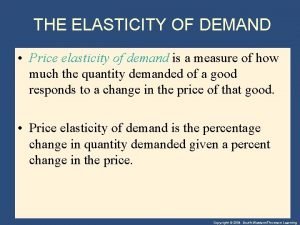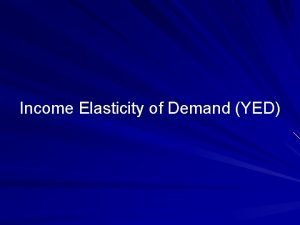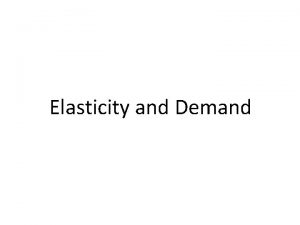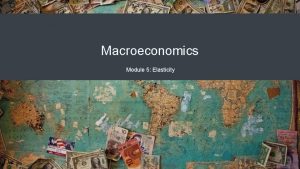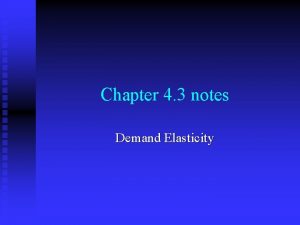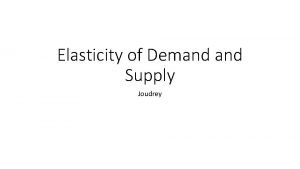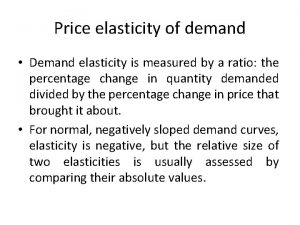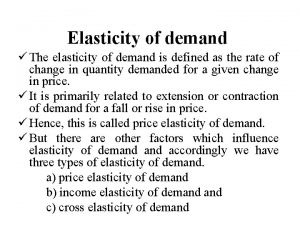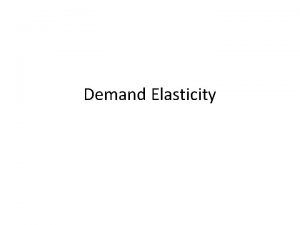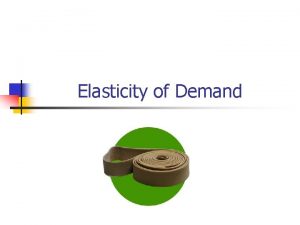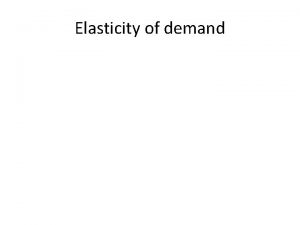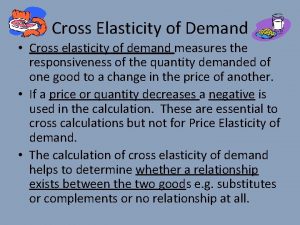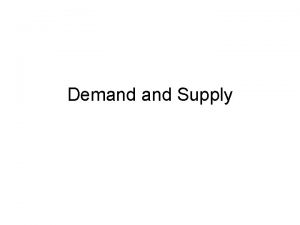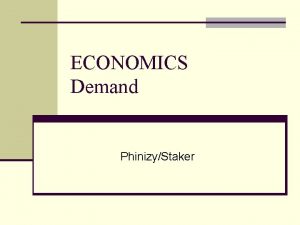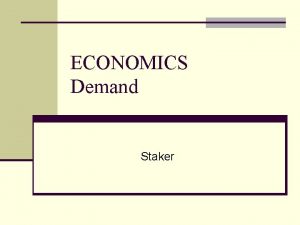Economics Module 5 Elasticity Elasticity of Demand Elasticity













































- Slides: 45

Economics Module 5: Elasticity

Elasticity of Demand Elasticity: an economics concept that measures responsiveness of one variable to changes in another variable. Types of elasticity • price elasticity of demand • price elasticity of supply • income elasticity of demand • cross-price elasticity of demand

Elasticity of Demand (cont. ) Elastic and Inelastic Demand Elastic Demand: a high responsiveness of quantity demanded or supplied to changes in price. 1. Example: A store owner raises prices, she can expect that the quantity demanded will drop, but she might not know how sensitive customers will be to the change. Inelastic Demand: a low responsiveness by consumers to price changes. • Example: Cigarette taxes and smoking rates. The greater the amount of the tax increase, the fewer cigarettes are bought and consumed.

Elastic and Inelastic Demand Analysis Factors helping to predict product demand as more or less elastic: • • • Substitutes Necessities vs. luxuries Share of the consumer’s budget Short run versus long run Competitive dynamics

Examples of Elastic and Inelastic Demand Which of the following products have elastic demand which have inelastic demand? • Gasoline • College textbooks • Coffee • Airline tickets • Concert tickets • Soft drinks • Medical procedures

Calculating Elasticity and Percentage Changes: Definitions • • Elastic Demand: when the calculated elasticity of demand is greater than one, indicating a high responsiveness of quantity demanded or supplied to changes in price. Elastic Supply: when the calculated elasticity of either supply is greater than one, indicating a high responsiveness of quantity demanded or supplied to changes in price. 1. 2. Inelastic Demand: when the calculated elasticity of demand is less than one, indicating a 1 percent increase in price paid by the consumer leads to less than a 1 percent change in purchases (and vice versa); this indicates a low responsiveness by consumers to price changes. Inelastic Supply: when the calculated elasticity of supply is less than one, indicating a 1 percent increase in price paid to the firm will result in a less than 1 percent increase in production by the firm; this indicates a low responsiveness of the firm to price increases (and vice versa if prices drop).

Calculating Elasticity and Percentage Changes: Definitions (cont. ) • • Midpoint Elasticity Approach: most accurate approach to solving for elasticity in which the growth rate, or percentage change in quantity demanded, is divided by the average of the two quantities demanded. Point Elasticity Approach: approximate method for solving for elasticity in which the initial quantity demanded is subtracted from the new quantity demanded, then divided by the initial price 1. Unitary Elasticity: when the calculated elasticity is equal to one indicating that a change in the price of the good or service results in a proportional change in the quantity demanded or supplied.

Calculating Elasticity and Percentage Changes: Calculations Calculating Elasticity The formula for calculating elasticity is: Example: For every 10 percent increase in the price of a pack of cigarettes, the smoking rates drop about 7 percent. Using the formula, we get:

Calculating Elasticity and Percentage Changes: Inelastic What does the number -0. 7 tell us about the elasticity of demand? • Negative sign reflects the law of demand: at a higher price, the quantity demanded for cigarettes declines. • The result of less than one says the size of the quantity change is less than the size of the price change. • It would take a relatively large price change to cause a relatively small change in quantity demanded. • Consumer responsiveness to a change in price is relatively small. When the elasticity is less than 1, demand is inelastic.

Calculating Elasticity and Percentage Changes: Elastic / Unitary Different Products, Different Price Elasticities of Demand • If the absolute value of the elasticity of a product is greater than one, the change in the quantity demanded is greater than the change in price. • Greater than one indicates a larger reaction to price change, which we describe as elastic. 1. If elasticity is equal to one, it means that the change in the quantity demanded is exactly equal to the change in price, so the demand response is exactly proportional to the change in price. We call this unitary elasticity, because unitary means one.

Calculating Elasticity and Percentage Changes Calculating Percentage Changes/Growth Rates Formula for computing growth rate: 1. Example: A job pays $10 per hour. At some point, the individual doing the job is given a $2 -per-hour raise. The percentage change (or growth rate) in pay is: 2. Solve for elasticity using the growth rate of the quantity demanded and the percentage change in price in order to to examine how these two variables are related. Use the point elasticity approach with product quantity demanded at 100 then moved to 103.

Calculating Elasticity and Percentage Changes (cont. ) Midpoint Elasticity Midpoint (or arc) elasticity approach: uses the average price and average quantity over the price and quantity change. Same Example: A job pays $10 per hour. At some point, the individual doing the job is given a $2 -per-hour raise. The percentage change (or growth rate) in pay is: 1. Solve for elasticity using the midpoint (or arc) elasticity approach with product quantity demanded at 100 then moved to 103.

Calculating Price Elasticities Using the Midpoint Formula The Midpoint Method : using the average percentage change in both quantity and price. • There are two formulas used for the midpoint method; the percent change in quantity, and the percent change in price. • The advantage of the midpoint method is that one obtains the same elasticity between two price points whethere is a price increase or decrease.

Calculating Price Elasticities Using the Midpoint Formula (cont. ) Calculate elasticity from points B to A: Step 1. Use price elasticity of demand formula Step 2. From the midpoint formula we know: Step 3. Use the values provided in the figure (as price decreases from $70 at point B to $60 at point A) in each equation: Step 4. Then, those values can be used to determine the price elasticity of demand:

Calculating Price Elasticities Using the Midpoint Formula (cont. II) Elasticity Is Not Slope • Common mistake to confuse the slope of either the supply or demand curve with its elasticity. • The slope is the rate of change in units along the curve, or the rise/run (change in y over the change in x). • The price elasticity, however, changes along the curve. • Elasticity is the percentage change— which is a different calculation from the slope, and it has a different meaning.

Categories of Elasticity: Definitions • • (Relatively) Elastic: the percentage change in quantity demanded is greater than the percentage change in price; measured price elasticity of demand is greater than one (in absolute value)(relatively). (Relatively) Inelastic: the percentage change in quantity demanded is less than the percentage change in price; measure price elasticity of demand is less than one (in absolute value).

Categories of Elasticity: Definitions (cont. ) • • • Unitary Elastic: when a given percent price change in price leads to an equal percentage change in quantity demanded. Perfectly (or infinitely) Elastic: the extremely elastic situation of demand or supply where quantity changes by an infinite amount in response to any change in price; horizontal in appearance. Perfectly Inelastic: the highly inelastic case of demand in which a percentage change in price, no matter how large, results in zero change in the quantity; thus, the price elasticity of demand is zero; vertical in appearance(relatively).

Categories of Elasticity • • Demand is described as elastic when the computed elasticity is greater than 1, indicating a high responsiveness to changes in price. Computed elasticities that are less than 1 indicate low responsiveness to price changes and are described as inelastic demand. 1. Unitary elasticities indicate proportional responsiveness of demand. In other words, the percent change in quantity demanded is equal to the percent change in price, so the elasticity equals 1.

Table 1. Three Categories of Elasticity: Elastic, Inelastic, and Unitary If… Then… And it’s called… % change in quantity is greater than % change in price Computed elasticity is greater than 1 Elastic % change in quantity is equal to % change in price Computed elasticity is equal to 1 Unitary % change in quantity is less than % change in price Computed elasticity is less than 1 Inelastic

Categories of Elasticity (cont. ) • • • Both elastic and inelastic are relative terms, as shown in Figure 1. As one moves down the demand curve from top left to bottom right, the measured elasticity is much greater than one (very elastic), then just greater than one (somewhat elastic), then equal to one (unitary elastic, then less than one (somewhat inelastic), and finally much less than one (very inelastic). Note that the epsilon symbol, ε, is often used to represent elasticity.

Categories of Elasticity: Polar Cases of Elasticity • Two extreme cases of elasticity: • • When computed elasticity equals zero. When computed elasticity is infinite. Note: Even though perfectly elastic and perfectly inelastic curves correspond to horizontal and vertical curves, remember that, in general, elasticity is not the same as the slope.

Categories of Elasticity: Polar Cases (cont. ) Perfectly (or infinitely) elastic demand curve refers to the extreme case in which the quantity demanded (Qd) increases by an infinite amount in response to any decrease in price at all. • Similarly, quantity demanded drops to zero for any increase in the price. • A perfectly elastic demand curve is horizontal, as shown in Figure 2 to the right. • Perfectly elastic demand is an “all or nothing” thing!

Categories of Elasticity: Polar Cases (cont. II) Perfectly inelastic demand is an extreme case, necessities with no close substitutes are likely to have highly inelastic demand curves. • This is the case with life-saving prescription drugs, like insulin. • A specific quantity of insulin is prescribed to the patient. Regardless of a price increase or decrease, the same quantity is needed to stay alive. • Perfectly inelastic demand means that quantity demanded remains the same when price increases or decreases. • Consumers are completely unresponsive to changes in price.

Price Elasticity of Supply Price elasticity of supply is the percentage change in the quantity of a good or service supplied divided by the percentage change in the price. • Measures how much quantity supplied changes in response to a change in the price. • Looks at how producers respond to a change in the price instead of how consumers respond.

Price Elasticity of Supply (cont. ) Calculate the price elasticity of supply from point A to B. • Assume that an apartment rents for $650 per month and at that price 10, 000 units are offered for rent, as shown in Figure 2, left. • When the price increases to $700 per month, 13, 000 units are offered for rent. • By what percentage does apartment supply increase? • What is the price sensitivity?

Calculating Price Elasticities of Supply Step 1. Use price elasticity of demand formula Step 3. Use the values provided in the in each equation: Step 2. From the midpoint formula we know: Step 4. Then, those values can be used to determine the price elasticity of demand:

Income Elasticity, Cross-Price Elasticity & Other Types of Elasticities Elasticity 1. How a percentage change in one variable causes a percentage change in another variable. 2. Elasticity does not just apply to the responsiveness of supply and demand to changes in the price of a product. 3. Quantity demanded (Qd) depends on income, tastes and preferences, population, expectations about future prices, and the prices of related goods. • Quantity supplied (Qs) depends on the cost of production, changes in weather (and natural conditions), new technologies, and government policies. • Elasticity can be measured for any determinant of supply and demand, not just the price.

Income Elasticity of Demand 1. For most products, most of the time, the income elasticity of demand is positive. 2. The percentage change in quantity demanded divided by the percentage change in income. • Formula:

Income Elasticity (cont. ) Income Elasticity of Demand • A rise in income will cause an increase in the quantity demanded • • These goods are referred to as normal goods. For a few goods, an increase in income means that one might purchase less of the good. • When the income elasticity of demand is negative, the good is called an inferior good.

Cross-Price Elasticity of Demand 1. Refers to the idea that the price of one good is affecting the quantity demanded of a different good. 2. Complement goods have negative cross-price elasticities. • If good A is a complement for good B, like coffee and sugar, then a higher price for B will mean a lower quantity of A consumed. • Substitute goods have positive crossprice elasticities of demand. • If good A is a substitute for good B, like coffee and tea, then a higher price for B will mean a greater quantity of A consumed.

Cross-Price Elasticity (cont. ) Calculating Cross-Price Elasticity of Demand • The cross-price elasticity of demand is the percentage change in the quantity of good A that is demanded as a result of a percentage change in the price of good B. • Formula:

Elasticity in Labor and Financial Capital Markets Wage Elasticity of Labor Supply: the percentage change in hours worked divided by the percentage change in wages. Interest Elasticity of Savings: the percentage change in the quantity of savings divided by the percentage change in interest rates. The formula is as follows:

Expanding the Concept of Elasticity • • The elasticity concept does not need to relate to a typical supply or demand curve at all. Whatever context elasticity is invoked, the idea always refers to percentage change in one variable. • The idea is almost always a price or money variable, and how it causes a percentage change in another variable, typically a quantity variable of some kind.

Table 1. Formulas for Calculating Elasticity Type Formula Income elasticity of demand = % change in Qd / % change in income Cross-price elasticity of demand = % change of Qd in A / % change of price in good B Wage elasticity of labor supply = % change in quantity of labor supplied / % change in wage Wage elasticity of labor demand = % change of labor demanded / % change in wage Interest rate elasticity of savings = % change in quantity of savings / % change in interest rate Interest rate elasticity of borrowing = % change in quantity of borrowing / % change in interest rate

Elasticity and Total Revenue and Elasticity of Demand • Studying elasticities is useful for a number of reasons, pricing being the most important. • The key concept in thinking about collecting the most revenue is the price elasticity of demand. • Total revenue is price times the quantity of tickets sold. (TR = P x Qd)

Table 1. Price, Elasticity, and Demand If demand is… Then… Therefore… Elastic % change in Qd is greater than % change in P • A given % rise in P will be more than offset by a larger % fall in Q so that total revenue (P times Q) falls • A given % fall in P will be more than offset than a larger % rise in Q so that total revenue (P times Q) rises Unitary % change in Qd is • A given % rise or fall in P will be exactly offset by an equal to % change % fall in Q so that total revenue (P times Q) is unchanged in P Inelastic % change in Qd is less than % change in P • A given % rise in P will cause a smaller % fall in Q so that total revenue (P times Q) rises • A given % fall in P will cause a smaller % rise in Q so that total revenue (P times Q) falls

Elasticity, Costs, and Customers and Changing Costs • What happens if the firm’s production costs change? • What is the impact on customers? • If the cost of a key input rises, can the firm pass along those higher costs to consumers in the form of higher prices? 1. 2. If new and less expensive ways of producing are invented, can the firm keep the benefits in the form of higher profits, or will the market pressure them to pass along the gains to consumers in the form of lower prices? The price elasticity of demand plays a key role in answering these questions.

Elasticity, Costs, and Customers (cont. ) • How would a technological breakthrough in aspirin production impact the market if it were inelastic? • How would a technological breakthrough in aspirin production impact the market if it were elastic?

Elasticity, Costs, and Customers (cont. II) Applying elasticity in the real world • What happens to the housing rental market there is a big boom in apartment production in your community? • What happens if demand is elastic? • What happens if demand is inelastic?

Elasticity, Costs, and Customers (cont. III) Long-Run vs. Short-Run Impact Demand • Elasticities are often lower in the short run than in the long run. • On the demand side of the market, it can sometimes be difficult to change Qd in the short run but easier in the long run. • The elasticity of demand for energy is somewhat inelastic in the short run, but much more elastic in the long run.

Elasticity, Costs, and Customers (cont. IV) Long-Run vs. Short-Run Impact Supply • For supply side of markets, producers of goods and services typically find it easier to expand production in the long term of several years rather than in the short run of a few months. • In the short run it can be costly or difficult to build a new factory, hire many new workers, or open new stores. But over a few years, all of these are possible. 1. 2. 3. In most markets for goods and services, prices bounce up and down more than quantities in the short run, but quantities often move more than prices in the long run. The underlying reason for this pattern is that supply and demand are often inelastic in the short run, so that shifts in either demand or supply can cause a relatively greater change in prices. Since supply and demand are more elastic in the long run, the long-run movements in prices are more muted, while quantity adjusts more easily in the long run.

Tax Incidence Elasticity and Tax Incidence • The analysis of how a tax burden is divided between consumers and producers is called tax incidence. • Tax incidence depends on the price elasticities of supply and demand. • Typically, the tax incidence, or burden, falls both on the consumers and producers of the taxed good. • To predict which group will bear most of the burden, examine the elasticity of demand supply.

Tax Incidence (cont. ) • When the demand is inelastic, consumers are not very responsive to price changes, and the quantity demanded reduces only modestly when the tax is introduced. • When a tax is added in a market with an inelastic supply, and sellers have no alternative than to accept lower prices for their business, taxes do not greatly affect the equilibrium quantity.

Quick Review • • • What is elasticity and give a few examples? Why is the demand for some goods either elastic or inelastic? How do you mathematically differentiate between elastic, inelastic, and unitary elasticities of demand? What is are percentage changes, or growth rates? How do you calculate price elasticity using the midpoint method? 1. 2. 3. What is the difference between a midpoint elasticity approach and the point elasticity approach in calculating elasticity? What is the difference between slope and elasticity? Explain and compare graphs for the following types of elasticities: elastic, inelastic, unitary, infinite, and zero.

Quick Review (cont. ) • • • How do you calculate the price elasticity of supply? How do you calculate the income elasticity of demand? What is cross-price elasticity of demand how do you calculate it? What is elasticity in labor and financial capital markets? How do differences in elasticity affect total revenue? 1. 2. 3. How do you evaluate how elasticity can cause shifts in demand supply? How can you predict how elasticity affects equilibrium in the long-run and the short-run? How do the price elasticities of demand supply determine the incidence of a tax on buyers and sellers?
 Module 5 supply and demand introduction and demand
Module 5 supply and demand introduction and demand What are the 5 determinants of price elasticity of demand
What are the 5 determinants of price elasticity of demand Acdc leadership
Acdc leadership Acdc leadership
Acdc leadership Arc elasticity of demand
Arc elasticity of demand Elasticity of demand formula
Elasticity of demand formula Own price elasticity
Own price elasticity Elasticity of demand
Elasticity of demand Promotional elasticity of demand
Promotional elasticity of demand Price elasticity of demand formula examples
Price elasticity of demand formula examples Yed formula
Yed formula Chapter 4 section 3 elasticity of demand answers
Chapter 4 section 3 elasticity of demand answers What are the 5 determinants of price elasticity of demand
What are the 5 determinants of price elasticity of demand Elasticity of demand formula
Elasticity of demand formula Own wage elasticity
Own wage elasticity What are the 5 determinants of price elasticity of demand
What are the 5 determinants of price elasticity of demand Perfectly inelastic demand
Perfectly inelastic demand Degree of elasticity of demand
Degree of elasticity of demand Promotional elasticity of demand
Promotional elasticity of demand High cross elasticity of demand
High cross elasticity of demand Arc elasticity of demand
Arc elasticity of demand Factors affecting price elasticity of demand
Factors affecting price elasticity of demand Objectives of elasticity of demand
Objectives of elasticity of demand Chapter 4 section 3 elasticity of demand
Chapter 4 section 3 elasticity of demand Lesson 3 elasticity of demand answers
Lesson 3 elasticity of demand answers Cross-price elasticity of demand formula
Cross-price elasticity of demand formula Elasticity table
Elasticity table Price elasticity of demand
Price elasticity of demand Quantity demanded formula
Quantity demanded formula Cross elasticity of demand midpoint formula
Cross elasticity of demand midpoint formula Elastic goods
Elastic goods Cross advertising elasticity measures
Cross advertising elasticity measures Cross wage elasticity of labor demand
Cross wage elasticity of labor demand Total expenditure method
Total expenditure method Why is elasticity of demand negative
Why is elasticity of demand negative Elasticity of demand formula calculus
Elasticity of demand formula calculus Price elasticity of supply
Price elasticity of supply Price elasticity of demand formula
Price elasticity of demand formula Measurements of elasticity of demand
Measurements of elasticity of demand Guided reading 4-3 elasticity of demand answers
Guided reading 4-3 elasticity of demand answers Yedyed
Yedyed How to find income elasticity
How to find income elasticity Economics and business economics maastricht
Economics and business economics maastricht Elements of mathematical economics
Elements of mathematical economics Ap economics module 1
Ap economics module 1 C device module module 1
C device module module 1


